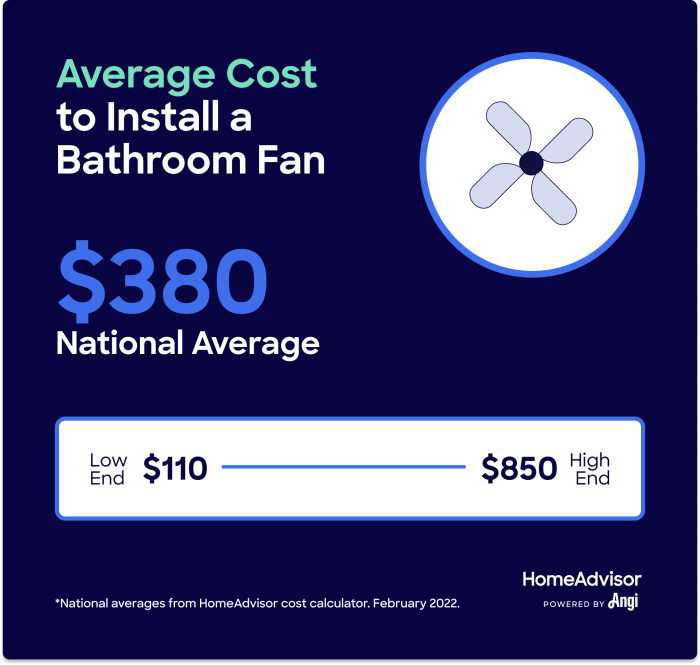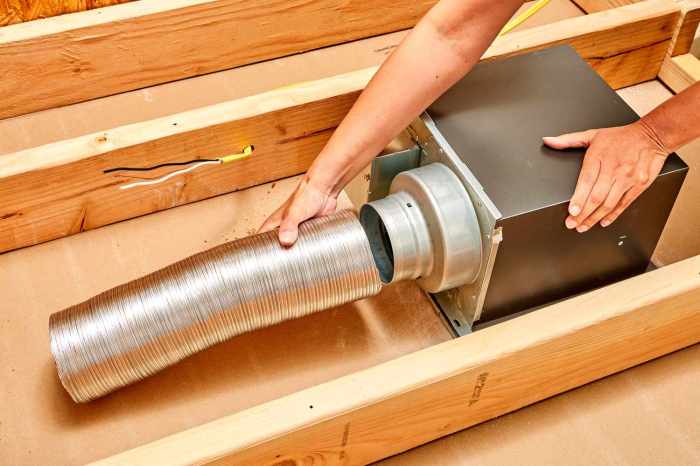Installing a bathroom exhaust fan is a crucial home improvement project that ensures proper ventilation and eliminates moisture and odors. Whether you’re planning a DIY installation or hiring a professional, understanding the cost estimates involved is essential for budgeting and planning.
This comprehensive guide will provide detailed information on material costs, labor estimates, factors affecting installation costs, and tips for saving money. We’ll also discuss the pros and cons of DIY versus professional installation, helping you make an informed decision for your specific needs.
Material Cost Estimates
The cost of materials needed to install a bathroom exhaust fan can vary depending on the size of the fan, the type of ductwork used, and other factors. However, you can expect to pay between $50 and $200 for materials.
The fan itself will typically cost between $20 and $100. Ductwork will cost between $10 and $50 per foot. Other materials, such as electrical wire, connectors, and mounting brackets, will cost between $10 and $20.
Factors Affecting Material Costs
- Size of the fan: Larger fans will require more materials and will therefore cost more.
- Type of ductwork: Flexible ductwork is less expensive than rigid ductwork, but it is also less durable.
- Length of the duct run: The longer the duct run, the more materials will be required and the higher the cost.
- Location of the fan: If the fan is installed in a difficult-to-reach location, it may require more materials and labor, which will increase the cost.
Factors Affecting Installation Costs
The cost of installing a bathroom exhaust fan can vary depending on several factors. These include the size of the bathroom, the location of the fan, and the type of fan chosen.
Bathroom Size
The size of the bathroom will affect the cost of installation in two ways. First, a larger bathroom will require a more powerful fan, which will cost more. Second, a larger bathroom will require more ductwork to connect the fan to the outside, which will also add to the cost.
Fan Location
The location of the fan will also affect the cost of installation. If the fan is installed in a difficult-to-reach location, such as on a high ceiling or in a tight crawlspace, it will cost more to install.
Type of Fan
The type of fan chosen will also affect the cost of installation. There are three main types of bathroom exhaust fans:
- Ceiling-mounted fans
- Wall-mounted fans
- Inline fans
Ceiling-mounted fans are the most common type of bathroom exhaust fan. They are installed in the ceiling and are usually the least expensive to install. Wall-mounted fans are installed on the wall and are usually more expensive to install than ceiling-mounted fans.
Inline fans are installed in the ductwork and are usually the most expensive to install.
Cost-Saving Tips
Bathroom exhaust fan installation costs can add up quickly, but there are several ways to save money on the project. By following these tips, you can reduce material costs, labor costs, and other expenses associated with installation.
Here are some specific examples of how to save money on each aspect of the installation process:
Material Costs
- Choose a fan with a lower CFM rating. CFM (cubic feet per minute) measures the amount of air the fan can move. A higher CFM rating means a more powerful fan, but it also means a higher price tag. If you have a small bathroom, you can get away with a fan with a lower CFM rating.
- Look for fans on sale. Many home improvement stores offer sales on exhaust fans throughout the year. You can also find discounts on fans online.
- Consider buying a fan with a built-in light. This will save you the cost of purchasing a separate light fixture.
Labor Costs
- Install the fan yourself. If you’re handy, you can save money by installing the fan yourself. There are many online tutorials that can show you how to do it.
- Get multiple quotes from contractors. Before hiring a contractor, get multiple quotes so you can compare prices.
- Negotiate with the contractor. Once you’ve found a contractor you want to work with, don’t be afraid to negotiate the price.
Other Expenses
- Use existing wiring. If there is already wiring in place for a light fixture in your bathroom, you can use it to power the exhaust fan.
- Vent the fan through the roof. Venting the fan through the roof is more expensive than venting it through the wall, but it’s also more efficient.
- Consider a solar-powered fan. Solar-powered fans are more expensive than traditional fans, but they can save you money on your energy bills in the long run.
Additional Considerations
In addition to the material and labor costs discussed earlier, there are several other factors to consider when budgeting for bathroom exhaust fan installation.
These include the need for permits, the cost of electrical work, and the potential for unexpected expenses. By planning for these additional costs upfront, you can avoid surprises during the installation process.
Permits
In some areas, a permit is required to install a bathroom exhaust fan. The cost of a permit varies depending on your location, but it is typically around $50 to $100.
Electrical Work
If you are not comfortable working with electricity, you will need to hire an electrician to install the fan. The cost of electrical work will vary depending on the complexity of the installation, but it is typically around $100 to $200.
Unexpected Expenses
There is always the potential for unexpected expenses during any home improvement project. When budgeting for bathroom exhaust fan installation, it is a good idea to add a buffer of 10% to 20% to your total cost estimate to cover any unforeseen expenses.
Final Summary
Installing a bathroom exhaust fan is an investment in your home’s comfort and health. By carefully considering the cost estimates, factors involved, and potential savings, you can ensure a successful installation that meets your budget and ventilation requirements. Remember, proper ventilation is crucial for preventing mold, mildew, and other moisture-related issues, contributing to a healthier and more comfortable living environment.



